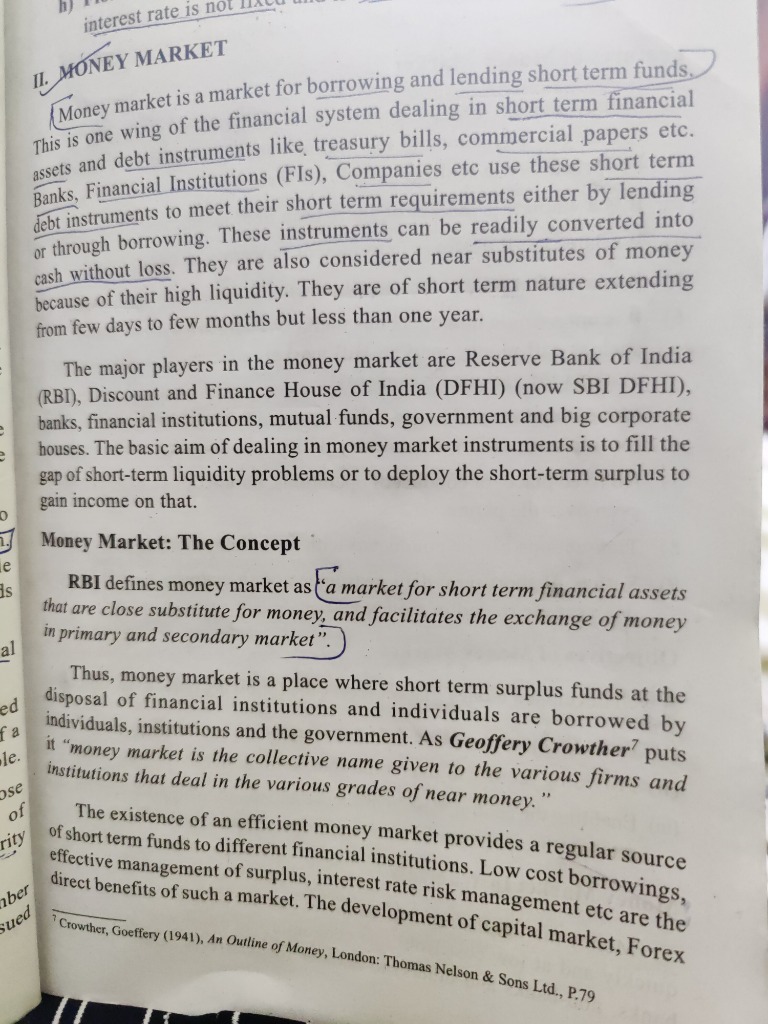Overview of Money Market: Key Concepts and Functions
Money Market Notes

Definition and Purpose
- Money Market: A financial market focused on borrowing and lending short-term funds. It deals with short-term financial assets and debt instruments such as treasury bills and commercial papers.
- Insight: These instruments are favored due to their high liquidity and safety, making them close substitutes for cash.
- Additional Information: Short-term typically refers to a period of one year or less.
Key Players
- Major Participants:
- Reserve Bank of India (RBI)
- SBI DFHI (formerly Discount and Finance House of India)
- Banks and financial institutions
- Mutual funds
- Government and large corporations
- Insight: These entities utilize the money market to manage liquidity and short-term funding needs efficiently.
Characteristics of Money Market Instruments
- Instruments can be readily converted into cash without loss, making them near money substitutes.
- Insight: This characteristic is crucial for managing a company’s or individual’s liquidity needs effectively.
- Additional Information: High liquidity implies quick conversion to cash without significantly affecting the instrument's market price.
Conceptual Understanding
- Definition by RBI: The money market is described as a place for exchanging short-term financial assets that are substitutes for money.
- Insight: This market facilitates both primary and secondary financial transactions, allowing for greater flexibility in fund management.
- Additional Information: Primary markets involve new issues of securities, while secondary markets involve trading existing securities.
Benefits
- Provides a regular source of short-term funds, ensuring easy access to capital.
- Allows for efficient management of surplus funds and risk management related to interest rates.
- Insight: Effective utilization of the money market can lead to reduced borrowing costs and improved financial stability.
- Additional Information: Companies can capitalize on these benefits to improve their cash flow and investment strategies.
Theoretical Perspective
- Geoffrey Crowther: Defined money market as a collective term for the firms and institutions dealing with near money.
- Insight: This includes various financial instruments that mimic the properties of actual currency in liquidity and stability.
- Additional Information: Near money includes assets like treasury bills and commercial papers which are not cash but can be easily converted to cash.
Development Impact
- The money market supports the broader development of the capital market and foreign exchange (Forex) markets.
- Insight: A robust money market is vital for the overall growth and sustainability of the financial ecosystem.
- Additional Information: It provides mechanisms for controlling liquidity, enhancing monetary policy effectiveness, and stabilizing the currency market.
These notes highlight the crucial role and mechanics of the money market, emphasizing its importance in the financial system.
Extended readings:
www.investopedia.com
Money Markets: What They Are, How They Work, and Who Uses Them
study.com
Money Market Definition, Types & Advantages - Study.com
www.elibrary.imf.org
Chapter 2 Money Markets and Monetary Policy Operations in